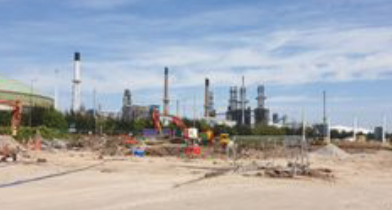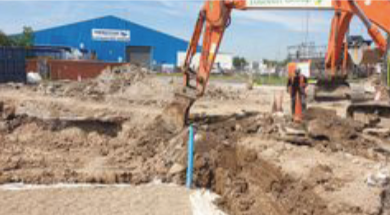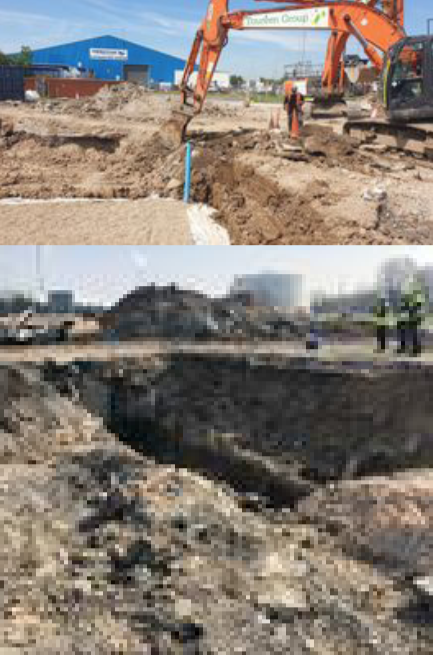Ad-Blue Leak Remediation in Lincolnshire
Geo2 were commissioned by a major UK fuel producer and retailer to manage environmental matters during the redevelopment and expansion of one of their flagship sites, which included a full knockdown and rebuild, the replacement of all tanks and underground infrastructure, and a doubling of the site’s footprint through the addition of a new HGV forecourt area.
Environmental Work
Environmental works included initial investigation of the site. Following the start of the development Geo2 were also commissioned to undertaken soil validation sampling from the sides and base of the excavation left following removal of the historical tanks. During this validation strong ammonia odours were noted coming from the ground, in the area of a historical HGV filling area. The odours were so strong that the contractor could not safely work, especially as the source of the release, and the nature of the contaminant, was unclear.
This represented a very serious situation for the client, as:
- The site was contaminated with an unknown contaminant. Neighbouring business adjoin the site who may be impacted by vapour, and watercourses on two sides of the property included protected species.
- The contractor on site could not proceed with the development until the source and type of contaminant were established so that appropriate H&S mitigation measures could be put in place.
- The contamination needed to be remediated in line with environmental responsibilities, UK law and redevelopment planning conditions.
- The delays with redevelopment were causing significant knock-on impacts for the programme, increasing contractor costs and delaying the opening of the store, with the resulting ultimate reduction in site sales.



Investigation
Investigation by Geo2 into possible causes concluded that the source was likely to be Ad-Blue, a diesel supplement used in HGVs and other diesel vehicles to reduce emissions. The product is based on industrial urea, and breaks down into ammonia. Investigation by the client discovered that there had been an incident with an Ad-Blue above-ground tank, underground line and pump fitted at the HGV filling area. This had occurred at a time following the Geo2 investigation, but prior to the redevelopment. It appeared likely that the losses associated with this leak had been vastly under-estimated by the third-party operator of the system at the time.
So that the source could be confirmed, Geo2 undertook soil and water sampling using full respiratory equipment. Samples were submitted for a range of determinands, including urea. Urea sampling is not a common determinand, so specialist laboratories had to be found for these works, although the turn-around time for the specialist analysis was protracted. This confirmed the source to be urea, and its breakdown products.
Contamination
Contamination was noted around the HGV filling area (the likely source area) but also in water and sediments in an adjacent watercourse. The ground at the site consists of a stiff clay, with little groundwater, and flooded during heavy rain. Soils between the source and the watercourse were unimpacted, so it was considered that the likely transmission route was via-high permeability pathways during heavy rainfall events, such as pea-gravel beds, located around drainage services, which ran to an interceptor, that discharged to the watercourse.
Investigation by Geo2 could find no record of a similar significant Ad-Blue release. As there appeared to be no UK precedent, rapid action on determining safe site specific target values was required, establishing a remediation working plan and engaging and agreeing the methods with the client, contractor and regulators in order to progress the works safely, quickly, efficiently and legally.

Remediation Works
Remediation was undertaken in the source area by mass excavation and disposal. As validation sampling turn-around times for urea were too long to be pragmatic, excavation was undertaken using hand-held vapour meters to field screen material. Careful screening of material was required, as the high organic content meant that significant disposal costs would otherwise be incurred. In addition, works were undertaken in the adjacent watercourse to carefully remove impacted sediments from the sides and base without causing further detrimental impact.
Final validation of the works was undertaken by a programme of water monitoring in adjacent watercourses, with regulatory sign-off being achieved.

